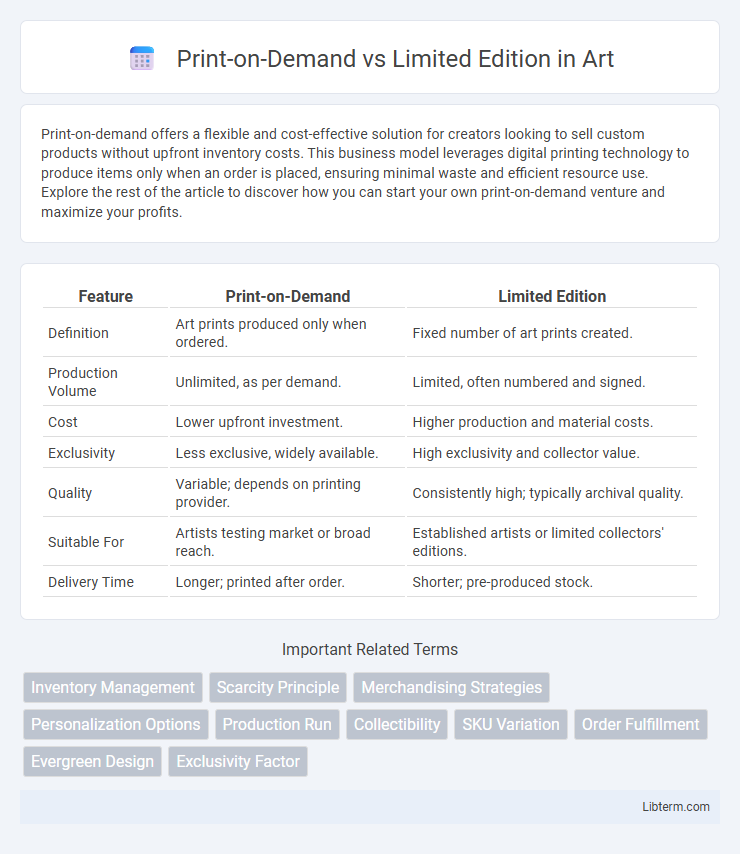Print-on-demand offers a flexible and cost-effective solution for creators looking to sell custom products without upfront inventory costs. This business model leverages digital printing technology to produce items only when an order is placed, ensuring minimal waste and efficient resource use. Explore the rest of the article to discover how you can start your own print-on-demand venture and maximize your profits.
Table of Comparison
| Feature | Print-on-Demand | Limited Edition |
|---|---|---|
| Definition | Art prints produced only when ordered. | Fixed number of art prints created. |
| Production Volume | Unlimited, as per demand. | Limited, often numbered and signed. |
| Cost | Lower upfront investment. | Higher production and material costs. |
| Exclusivity | Less exclusive, widely available. | High exclusivity and collector value. |
| Quality | Variable; depends on printing provider. | Consistently high; typically archival quality. |
| Suitable For | Artists testing market or broad reach. | Established artists or limited collectors' editions. |
| Delivery Time | Longer; printed after order. | Shorter; pre-produced stock. |
Understanding Print-on-Demand: Definition and Process
Print-on-Demand (POD) is a digital printing technology that allows artists and businesses to produce items only when an order is placed, eliminating the need for large upfront inventory. The POD process involves uploading design files to a platform where products such as apparel, books, or home decor are printed, packaged, and shipped directly to customers, ensuring cost efficiency and reduced waste. This model contrasts with Limited Edition production, which relies on pre-printed, finite quantities, making POD ideal for flexible, on-demand manufacturing.
What Constitutes a Limited Edition Release?
A limited edition release is characterized by a fixed number of copies produced, often individually numbered or signed to enhance exclusivity and value. Unlike print-on-demand products, which are created as orders come in with no fixed quantity, limited editions are deliberately restricted to create scarcity and collectible appeal. This scarcity, combined with unique features such as special packaging or artist involvement, sets limited editions apart from standard or on-demand prints.
Key Differences Between Print-on-Demand and Limited Edition
Print-on-Demand offers unlimited reproduction with minimal upfront cost, allowing artists to scale without inventory risk, while Limited Edition prints are produced in fixed quantities, enhancing exclusivity and collector value. Print-on-Demand utilizes digital printing technology for on-demand creation, whereas Limited Edition often involves traditional methods like lithography or etching to ensure higher quality and authenticity. Pricing models differ significantly; Print-on-Demand is generally lower priced due to mass availability, contrasting with the premium pricing of Limited Edition prints driven by scarcity and uniqueness.
Production Flexibility: On-demand Printing vs Finite Runs
Print-on-demand offers unmatched production flexibility by enabling single-item creation only when orders are placed, eliminating inventory costs and allowing rapid design updates. Limited edition prints rely on finite runs predetermined before production begins, which restricts adaptability but enhances exclusivity and collectibility. Choosing between on-demand printing and limited runs depends on balancing the need for customization and scalability against the value of scarcity and controlled availability.
Cost Implications: Upfront Investment and Pricing Strategies
Print-on-Demand eliminates upfront inventory costs, allowing sellers to produce items only after a sale, which reduces financial risk but results in higher per-unit prices. Limited Edition products require significant upfront investment in production and inventory, but enable premium pricing due to exclusivity and collectible value. Pricing strategies must balance cost recovery and market demand, with Print-on-Demand focusing on volume and Limited Edition emphasizing scarcity and perceived value.
Customer Experience: Personalization vs Exclusivity
Print-on-Demand offers customers high personalization by allowing them to customize designs, sizes, and products tailored to individual preferences, enhancing user engagement. Limited Edition products create a sense of exclusivity and urgency, appealing to collectors and enthusiasts who value rarity and uniqueness. Combining both strategies can optimize customer satisfaction by delivering tailored experiences along with the allure of exclusive ownership.
Market Trends: Popularity and Demand Shifts
Print-on-Demand (POD) has surged in popularity due to its low upfront costs and ability to cater to niche markets with personalized products, driving rapid demand growth in e-commerce and independent creator platforms. Limited Edition items maintain strong appeal among collectors and luxury consumers, sustaining higher price points and exclusivity but experiencing slower market expansion compared to POD. Current market trends indicate a shift towards POD for mass accessibility and customization, while Limited Edition remains a strategic choice for brand differentiation and premium positioning.
Environmental Impact: Sustainability and Waste Reduction
Print-on-demand significantly reduces environmental impact by producing items only when ordered, minimizing overproduction and waste commonly associated with traditional limited edition runs. Limited edition products often involve large upfront manufacturing, leading to excess inventory and increased resource consumption. Emphasizing sustainability, print-on-demand models optimize material usage and lower carbon footprints, supporting eco-friendly consumer practices.
Best Use Cases for Print-on-Demand and Limited Editions
Print-on-Demand is ideal for testing new designs, minimizing upfront costs, and catering to niche audiences with customized products due to its flexibility and low inventory risk. Limited Editions are best suited for creating exclusivity, boosting brand prestige, and targeting collectors or loyal customers willing to pay a premium for scarce, unique items. Businesses benefit from Print-on-Demand when focusing on rapid market entry and diverse product ranges, while Limited Editions excel in driving high-value sales and enhancing brand loyalty through scarcity.
How to Choose the Right Model for Your Creative Business
Choosing between Print-on-Demand (POD) and Limited Edition models depends on your business goals, target audience, and production capacity. POD offers low upfront costs, scalability, and the ability to test designs without inventory risks, making it ideal for emerging artists or businesses prioritizing flexibility. Limited Edition appeals to collectors and builds exclusivity by producing a fixed number of unique items, which can drive higher prices and brand prestige but requires careful inventory and demand management.
Print-on-Demand Infographic

 libterm.com
libterm.com